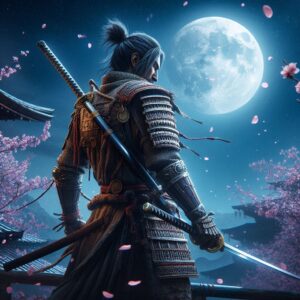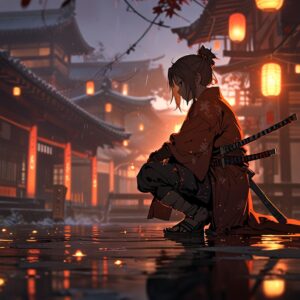In the 1980s, was the age of gold for video gaming in Japan, and companies like Nintendo, Sega, and gaining prominence Sony set the stage for it. Entire genres and conventions would emerge in gaming as time went on, which still exist today. “Super Mario Bros.” by Nintendo and “Sonic the Hedgehog” by Sega achieved so much success that they literally went beyond borders and cultures, making enormous impacts all over the world and thus attaining the status of household names. Their universal appeal derived from the brilliant gameplays inherent in the titles and the cultural subtleties introduced within which, resonated with local audiences.
 Japanese games have a tendency to run very deep and very complicated in narrative, a practice influenced by the country’s rich history of myth and folklore. Specifically, this penchant for storytelling has allowed the genre of role-playing games (RPGs) such as “Final Fantasy” and “Dragon Quest” to flourish. Only detailed worlds, compelling characters, and epic tales that were somehow parallel to those seen in classic Japanese literature and theatre would appear in their presence. In allowing story-driven experiences one-level emotional access to the player, a much deeper connection to the virtual world would happen as a result. Western games, by comparison, would seem to lay greater emphasis on action and realism.
Japanese games have a tendency to run very deep and very complicated in narrative, a practice influenced by the country’s rich history of myth and folklore. Specifically, this penchant for storytelling has allowed the genre of role-playing games (RPGs) such as “Final Fantasy” and “Dragon Quest” to flourish. Only detailed worlds, compelling characters, and epic tales that were somehow parallel to those seen in classic Japanese literature and theatre would appear in their presence. In allowing story-driven experiences one-level emotional access to the player, a much deeper connection to the virtual world would happen as a result. Western games, by comparison, would seem to lay greater emphasis on action and realism.
You can clearly see the impact of manga and anime in the vibrant colors and personality-rich character designs. Games such as “Legend of Zelda” and “Pokémon” adopt this style, infusing their worlds with striking visual beauty and unparalleled originality. Such design decisions deeply touch players, allowing them to enter realms that are bizarre yet strangely warm and welcoming.
True to the Japanese aesthetic, minimalist yet functional design says the games’ navigation and experience are really intuitive. Such easiness increases accessibility and appeal, allowing people from different walks of life to enjoy the adventure without fighting against awkward controls.
Cultural Elements in Gameplay
The presence of cultural elements in Japanese games imparts a richness to the gaming experience, serving as a kind of window into Japan’s customs and traditions. From subtle hints to overt representations, these inclusions of culture add depth and authenticity to the games, making them stand out.
 Shinto and Buddhist traditions heavily influence titles like “Okami” and “Nioh,” mainly in terms of spirituality and morality. By adding elements of folklore, such as the yokai—supernatural spirits—and kami—gods—stories, players are introduced to aspects of Japanese culture through which the game becomes more interesting: narratives that are both educational and captivating.
Shinto and Buddhist traditions heavily influence titles like “Okami” and “Nioh,” mainly in terms of spirituality and morality. By adding elements of folklore, such as the yokai—supernatural spirits—and kami—gods—stories, players are introduced to aspects of Japanese culture through which the game becomes more interesting: narratives that are both educational and captivating.
These cultural specifics present a form of understanding and appreciation between diverse communities. Through the medium of video games, players come to learn about customs, beliefs, and historical events, which, together with a powerful sense of storytelling and interactivity, enhance their awareness and curiosity about other cultures.
“Harmony,” or wa, is an essential idea in Japanese society. Balance and tranquility are the kind of ideal that is seen in many games developed in Japan, where players are often encouraged to find a balance between opposing forces. In games like Harvest Moon and Animal Crossing, players farm, fish, and construct homes within a village, aiming to create a harmonious whole. The games have a calming and relaxing influence, stressing cooperation and connection rather than conflict and destruction.
Honor and loyalty are themes that run deeply in Japanese culture, including in its games. The samurai genre delves into these ideas, with games such as Sekiro: Shadows Die Twice and Ghost of Tsushima presenting protagonists who adhere to strict moral codes and loyalty. By engaging in such narratives, players are introduced to some of the ideals that underlie Japanese society, which can lead to sympathy and understanding.
Genres Born and Perfected in Japan
Although role-playing games originated in Western tabletop venues, the Japanese version, known as JRPGs (Japanese Role-Playing Games), has established its own identity as a genre. The “Final Fantasy” and “Persona” series are prime examples of JRPGs with character-centric narratives, tactical battles, and elaborate storytelling. In many cases, turn-based battles and linear narratives are features of JRPGs (as opposed to Western RPGs), with an emphasis on narrative depth and emotional weight rather than open-world exploration.
Japan’s impact on the fighting game genre is impressive: classics like “Street Fighter” and “Tekken” were born there. These games have very powerful mechanics, balance, and competition and have grown into worldwide esports communities. Their success would be the ideal mixture of being easy enough for newcomers to get into but deep enough for it to please the veteran, a trait of Japanese game design perfection.
Creative precision in Japanese culture has brought forth rhythm and puzzle games such as “Tetris,” and, while a game of Russian origin, it became an unparalleled success in Japan, along with “Dance Dance Revolution.” Such games measure players’ reflexes and problem-solving capabilities and serve up a tantalizing blend that, once tasted, makes the player crave more.
The Impact and Legacy
The global influence of Japanese games has been tremendous, with players and developers around the world impacted by their philosophies. The industry is still shaped and inspired by the legacy of this unique approach to design and storytelling.
 Many game developers in the West have borrowed ideas from Japanese developers, adopting similar ways of narrating a story, art visuals, and gameplay principles. Games like “The Last of Us” and “Undertale” are rich examples of this new blending—melding Japanese narrative and visual flourishes with distinctly Western elements—and thus show a deepening fusion of cultural influences.
Many game developers in the West have borrowed ideas from Japanese developers, adopting similar ways of narrating a story, art visuals, and gameplay principles. Games like “The Last of Us” and “Undertale” are rich examples of this new blending—melding Japanese narrative and visual flourishes with distinctly Western elements—and thus show a deepening fusion of cultural influences.
The triumph of Japanese games has led to a very fruitful two-way exchange of ideas and concepts between Eastern and Western studios. By adopting different philosophies and design principles, developers have created experiences that speak to a global audience, enriching the increasingly mutable landscape of the industry with their work.
Video games from Japan have ignited some of the most passionate fandoms, resulting in a boundless outpouring of creativity visible in fan art, merchandise, and cosplay. Events like Anime Expo and Comic-Con manifest this love for Japanese characters and worlds, providing locations for fans to come together and share their passion for, and essentially celebrate, favorite franchises.
Online gaming communities and competitive esports, too, owe a great deal of growth to the Japanese titles. In that vein, “Super Smash Bros.” has fostered huge, vibrant scenes complete with devoted players and admirers, which host tournaments around the world and bring folks together, forging bonds over a mutual love for games.